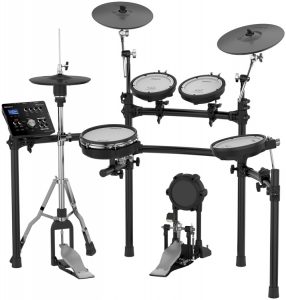So you have started playing the drums and you are having fun but would like to be able to practice at home. Here are 3 things you need to know before buying your first kit.
-
Acoustic or Electric
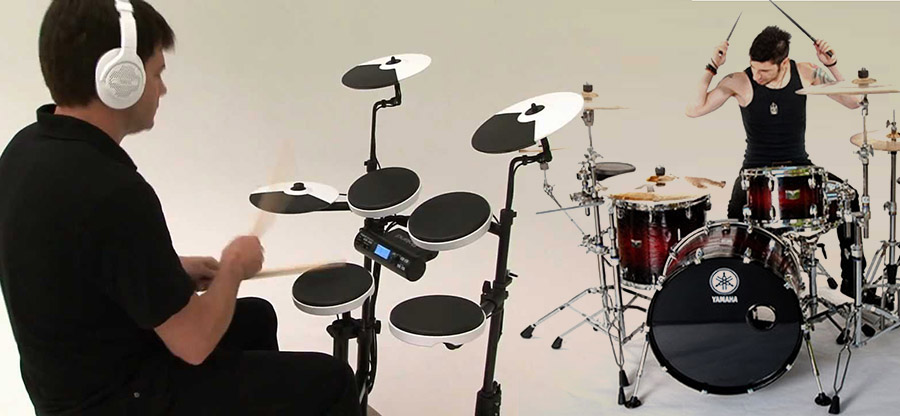
When you are looking at getting a drum kit for practice at home the first thing you need to decide is if you need an electric or acoustic kit. Acoustic kits are normally made up of a bass drum, toms a snare drum, hi hat, crash and ride cymbal. As you can imagine acoustic drums can be loud instruments with big resonant shells and crashing cymbals but they don’t always have to be if you get silencer pads quieter sticks or smaller drum sizes. Electric kits are generally smaller and are made up of rubber or mesh pads that take the place of the acoustic drums and cymbals these are controlled by a drum module which generates different sounds. To hear an electric kit whilst you are practicing you will need a set of headphones or an amplifier.
With both kits, you will need drumsticks, a stool to sit on and a pedal for the bass drum. A lot of beginner packages will include these but it’s best to check before you buy. It would also be advisable to have music stand so you can work on written exercises and pieces.
My advice is if you can accommodate an acoustic kit it is the best option as you will get a lot more for your money and it will really help develop your touch and dynamics. If noise is a problem an electric kit is probably the best bet and will allow you to practice freely but you should try and play the acoustic drums where possible. You can also find a much more detailed article on the differences here .
2. Budget
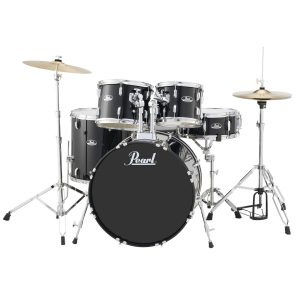
Once you have decided the type of kit you are going for my advice would be to buy the best you can afford.
There are some great beginner options but if you are serious about playing a good quality drum kit can last a lifetime.
Beginner acoustic drum kits start at around £250 but you can get a cheaper kit second hand.
Beginner electric kits start at around £300 but are generally more expensive than acoustic kits.
Here are my acoustic kit recommendations by budget. (based on what is available when this was written Feb 2018)
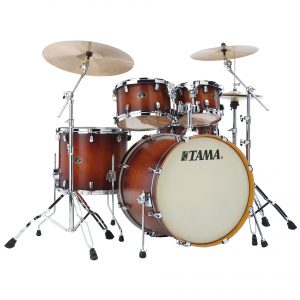
£300 Mapex Tornado Starter Kit
£450 Pearl Roadshow
£600+ Yamaha Stage Custom / Tama Silverstar / Gretsch Catalina
You may also be able to get a great deal on a second-hand acoustic kit but remember you will need a stool, cymbals a pedal and stands to go with it. You can also steadily upgrade an acoustic kit with new higher quality drum heads, different cymbals and extra percussion customising it to your own sound.
Here are my electric kit recommendations by budget. (based on what is available when this was written Feb 2018, updated October 2018 with new Roland kits)
£350 Yamaha DTX400
£399 Roland TD1K
£450 Yamaha DTX450
£650 Roland TD11K (This is a really great kit!)
£775 Roland TD 17K
£1107 Roland TD17KV
£1600 Roland TD25k
You might notice some other brands pop up when you search online for electric kits that seem great value but my experience is that they are not as satisfying to play but I would encourage you to try all the options out and decide for yourself at a local music shop.
3. Where to Buy, Music Shop or Online
I would always recommend going to a local music shop rather than buying online especially for your first kit. You can get great advice and often will be able to try the kit before you buy.
I recommend the following 2 shops as they have excellent stock and great helpful staff.
If you decide to buy online make sure you research what you are getting thoroughly.
Other things to consider.
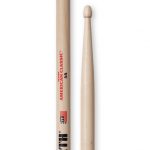 Sticks
Sticks
The most common stick size is a 5A and that is what I recommend to all beginner drummers, but you can try out different sticks which are different weights lengths and with different tips and decide what is right for you. If you play acoustic drums getting a set of hot rods or brushes is a great way to practice quietly an experiment with different tones on the drums.
 Electric Kit Amplifiers
Electric Kit Amplifiers
Most electric kits are designed to be used with headphones for quiet practice but you can buy an amplifier so you can play the kit out loud. These need to be fairly big speakers to properly produce the full range of the drumkit but smaller options can also work well you just need to be careful not to overload them.
Practice Pads
Practice pads are a surface normally made of rubber which allows drummers to practice their rhythms and technique without the distraction of the full kit. They are a great way of building your skills and can be taken pretty much anywhere.
Drum Kit Silencer Pads
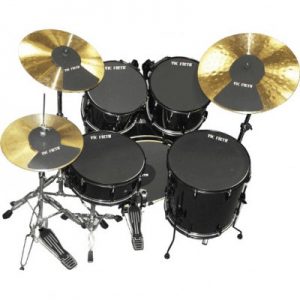
If you have an acoustic kit you can get silencer pads to reduce the volume of practice, It’s best to get a full set that includes the cymbals. These are fine for practice but do get a bit uninspiring after a while, I would recommend playing a quieter dynamic with brushes or hot rods over silencer pads.
I hope this article has helped you decide the sort of drumkit to get. Please get in touch if you would like some further advice or would be interested in taking drum lessons with me.
ultrastu@gmail.com 07828589751

